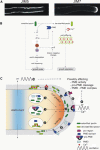Pectin methylesterases and pectin dynamics in pollen tubes
- PMID: 16322606
- PMCID: PMC1315365
- DOI: 10.1105/tpc.105.037473
Pectin methylesterases and pectin dynamics in pollen tubes
Figures


References
-
- Benkert, R., Obermeyer, G., and Bentrup, F.W. (1997). The turgor pressure of growing lily pollen tubes. Protoplasma 198, 1–8.
-
- Bosch, M., and Hepler, P.K. (6October2005). Silencing of the tobacco pollen pectin methylesterase NtPPME1 results in retarded in vivo pollen tube growth. Planta http://dx.doi.org/10.1007/s00425-005-0131-x. - DOI - PubMed
Publication types
MeSH terms
Substances
LinkOut - more resources
Full Text Sources

